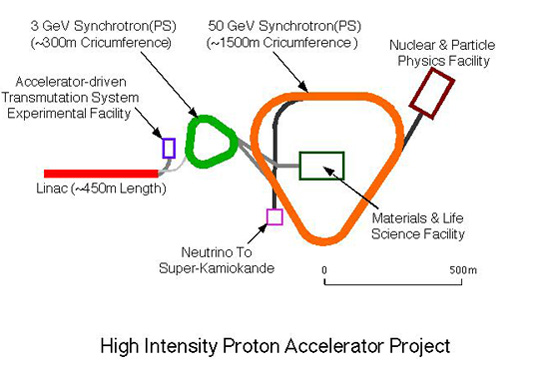J-PARC, Japan Proton Accelerator Research Complex, aims to pursue frontier science in particle physics, nuclear physics, materials science, life science and nuclear technology, using a new proton accelerator complex at the highest beam power in the world. The plan has been discussed and proposed jointly by the High Energy Accelerator Research Organization (KEK) and the Japan Atomic Energy Agency (JAEA). Previously these institutions proposed the Japan Hadron Facility (JHF) at KEK and the Neutron Science Project(NSP) at JAEA, respectively. The present joint project is based on these past proposals.
The accelerator complex consists of following accelerators:

400-MeV normal-conducting Linac,
600-MeV superconducting Linac to increase the energy from 400 to 600 MeV,
3-GeV synchrotron ring, which provides proton beams at 333micoA (1MW), and
50-GeV synchrotron ring, which provides proton beams at 15microA (0.75MW).
In addition, an upgrade towards 5-MW proton beam power at the few GeV energy region is proposed as a next step in the future. These accelerators will be constructed at the Tokai campus of JAEA, about 130km north-east of Tokyo.
At the 50-GeV Proton Synchrotron (PS), nuclear/particle physics experiments using kaon beams, antiproton beams, hyperon beams and primary proton beams are planned. Using kaon beams, production of strangeness in nuclear matter become possible, and the study of the influence of nuclear matter on this impurity probe of a strange particle will be performed. Experiments on kaon rare decays, such as K0 -> pi0 nu nu-bar to measure CP matrix elements, experiments on neutrino oscillation using the Super-Kamiokande as a detector, etc. will also be carried out.
The 3-GeV ring will be used as a booster synchrotron for the 50-GeV main ring. In addition, it is designed to provide beam power of 1 MW. Extensive physics programs which cover nuclear/particle physics, condensed matter physics, materials sciences and structural biology will be carried out there. Among them, the major highlights are materials sciences and structural biology using neutrons produced in proton+nucleus spallation reactions. Since a neutron has a magnetic moment but no electric charge, neutrons can be used for the study of magnetic properties of matter. Also, since the neutron has a mass which is similar to that of the hydrogen atom, neutrons can probe sensitively the location and dynamic behavior of hydrogen atoms in materials. The role of hydrogen atoms in biological cells is of particular interest in life science and, there, the neutron beams play a crucial role for these studies. In addition to neutrons, muon beams are also important in which muSR (muon spin rotation/relaxation), muon catalyzed fusion, and other materials sciences can be conducted. Also, particle physics experiments such as a muN -> eN conversion experiment can be performed. Radioactive beams produced from the 3-GeV PS are also useful to nuclear/astro physics research. Finally, the high current 600-MeV Linac will be used for R&D for the accelerator-driven nuclear transmutation.